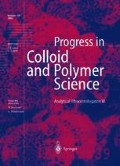Abstract
Density gradient measurements inside an analytical ultracentrifuge (AUC) are an excellent tool for characterizing nanoparticles in the 10—1000-nm diameter range. Because of its very high resolution (i.e. its fractionation power according to the particle density and its high precision) it is possible to analyze the chemical nature of nanoparticles, especially of complex colloidal mixtures. This means that AUC density gradient measurements are a kind of particle density spectroscopy. Usually, the relation between the radial position and particle density, ρ(r), inside an AUC density gradient is calculated by using the well-known (barometrical) equilibrium equation in the formulation of Hermans and Ende (1963); however, this equation for an ideal bimodal density gradient mixture fails in some cases. The higher the content of the heavy component, and the bigger the difference between the actual density gradient being formed and the equilibrium gradient, the bigger the failure or the deviation from ideality. We report a systematic study of these deviations using a marker nanoparticle system of 11 precisely characterized ethylhexyl acrylate/methyl acrylate copolymer latices with known nearly equidistant particle densities. During this study we also learned to use this 11-marker system as a pragmatic and simple calibration system for aqueous density gradients, thereby reducing considerably the error of the measurements in absolute nanoparticle densities. Some application examples are presented. One advantage of the new calibration technique is that higher particle densities are now accessible. Another advantage is the reduction in the measuring time. We no longer have to wait till equilibrium is reached (sometimes up to 90 h!); instead already after 9 h we get reasonable results. This means our static density gradient now approaches a “dynamic” one.
Access this chapter
Tax calculation will be finalised at checkout
Purchases are for personal use only
Preview
Unable to display preview. Download preview PDF.
References
Lange H (1980) Colloid Polym Sci 258:1077–1085
Mächtle W (1984) Colloid Polym Sci 262:270–282
Mächtle W (1992) In: Harding SE, et al (ed) AUC in biochemistry and polymer science. Royal Society of Chemistry, Cambridge, pp 147–175
Mächtle W, Ley G, Rieger J (1995) Colloid Polym Sci 273:708–716
Mächtle W, Ley G, Steib J (1995) Colloid Polym Sci 99:144–153
Kirsch S, Doerk A, Bartsch E, Sillescu H, Landfester K, Spieß W, Mächtle W (1999) Macromolecules 32:4508–4518
Mächtle W (1999) Prog Colloid Polym Sci 113:1–9
Leyrer RJ, Mächtle W (2000) Macromol Chem Phys 201:1235–1243
Hermans JJ, Ende HA (1963) J Polym Sci Part C Polym Symp 1:161–177
Hearst JE, Vinograd J (1961) Proc Natl Acad Sci USA 47:999–1004
Hearst JE, Vinograd J (1961) Proc Natl Acad Sci USA 47:1005–1014
Munk P (1982) Macromolecules 15:500–505
Lechner MD (1997), Macromol Rapid Commun 18:781–786
Lechner MD, Mächtle W, Sedlack U (1997) Prog Colloid Polym Sci 107:148–153
Lechner MD, Borchard W (1999) Eur Polym J 35:371–376
Lechner MD, Mächtle W, Sedlack U (1997) Prog Colloid Polym Sci 107:154–158
Mächtle W (1999) Biophys J 76:1080–1091
Author information
Authors and Affiliations
Editor information
Rights and permissions
Copyright information
© 2002 Springer-Verlag
About this paper
Cite this paper
Mächtle, W., Lechner, M.D. (2002). Evaluation of equilibrium and nonequilibrium density gradients in an analytical ultracentrifuge by calibration with marker particles. In: Borchard, W., Straatmann, A. (eds) Analytical Ultracentrifugation VI. Progress in Colloid and Polymer Science, vol 119. Springer, Berlin, Heidelberg. https://doi.org/10.1007/3-540-44672-9_1
Download citation
DOI: https://doi.org/10.1007/3-540-44672-9_1
Published:
Publisher Name: Springer, Berlin, Heidelberg
Print ISBN: 978-3-540-42489-5
Online ISBN: 978-3-540-44672-9
eBook Packages: Springer Book Archive

